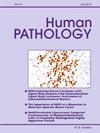Insights from single cell and bulk RNA sequencing: increased NOTCH signaling is correlated with oncogenic transformation of juxtaglomerular cells to juxtaglomerular cell tumors
IF 2.6
2区 医学
Q2 PATHOLOGY
引用次数: 0
Abstract
Renin-expressing juxtaglomerular cells in the kidney are the cell of origin for rare juxtaglomerular cell tumors, and affected patients often experience prolonged diagnostic odysseys as they present with relatively nonspecific symptoms related to secondary hypertension. While NOTCH1-3 gene rearrangements are the predominant molecular finding in similar (non-renin producing) “myopericytic” cell-derived glomus tumors that occur at renal and non-renal sites, such alterations have been reported in only isolated cases of juxtaglomerular cell tumors. As pathogenic mechanisms contributing to the oncogenic transformation of juxtaglomerular cells to renin-producing tumors are poorly defined due to their extreme rarity, we compared single cell RNA sequencing data for (non-neoplastic) juxtaglomerular cells to bulk whole transcriptomic data for a series of six fusion-negative juxtaglomerular cell tumors. Unsupervised clustering revealed substantial alterations in gene expression in juxtaglomerular cell tumors compared to their cell of origin, including significant over-expression of markers that are diagnostically relevant (renin/GATA3), and other (upregulated) markers of interest including CD34, NOTCH2/3, PDGFRB, JAG1, and NTRK3. Finally, the majority of juxtaglomerular cell tumors showed increased NOTCH pathway signaling. These findings help better define the pathologic basis of oncogenic transformation of juxtaglomerular cells to renin-expressing tumors and may be informative regarding therapeutic options in unresectable or rare cases of metastatic juxtaglomerular cell tumors.
单细胞和大量RNA测序的见解:增加的NOTCH信号与肾小球旁细胞向肾小球旁细胞肿瘤的致癌转化有关。
肾脏中表达肾素的肾小球旁细胞是罕见肾小球旁细胞瘤的起源细胞,受影响的患者往往表现出与继发性高血压相关的相对非特异性症状,因此诊断困难时间较长。虽然NOTCH1-3基因重排是发生在肾脏和非肾脏部位的类似(不产生肾素)“肌外细胞性”细胞源性肾小球肿瘤的主要分子发现,但这种改变仅在肾小球旁细胞肿瘤的个别病例中被报道。由于肾小球旁细胞极其罕见,导致肾小球旁细胞癌转化为肾素产生肿瘤的致病机制尚不明确,因此我们将(非肿瘤性)肾小球旁细胞的单细胞RNA测序数据与一系列6个融合阴性肾小球旁细胞肿瘤的大量全转录组数据进行了比较。无监督聚类显示,与起源细胞相比,肾小球旁细胞肿瘤的基因表达发生了实质性变化,包括与诊断相关的标记物(肾素/GATA3)的显著过表达,以及其他(上调的)感兴趣的标记物,包括CD34、NOTCH2/3、PDGFRB、JAG1和NTRK3。最后,大多数肾小球旁细胞肿瘤显示NOTCH信号通路增加。这些发现有助于更好地定义肾小球旁细胞癌转化为肾素表达肿瘤的病理基础,并可能为不可切除或罕见转移性肾小球旁细胞肿瘤的治疗选择提供信息。
本文章由计算机程序翻译,如有差异,请以英文原文为准。
求助全文
约1分钟内获得全文
求助全文
来源期刊

Human pathology
医学-病理学
CiteScore
5.30
自引率
6.10%
发文量
206
审稿时长
21 days
期刊介绍:
Human Pathology is designed to bring information of clinicopathologic significance to human disease to the laboratory and clinical physician. It presents information drawn from morphologic and clinical laboratory studies with direct relevance to the understanding of human diseases. Papers published concern morphologic and clinicopathologic observations, reviews of diseases, analyses of problems in pathology, significant collections of case material and advances in concepts or techniques of value in the analysis and diagnosis of disease. Theoretical and experimental pathology and molecular biology pertinent to human disease are included. This critical journal is well illustrated with exceptional reproductions of photomicrographs and microscopic anatomy.
 求助内容:
求助内容: 应助结果提醒方式:
应助结果提醒方式:


